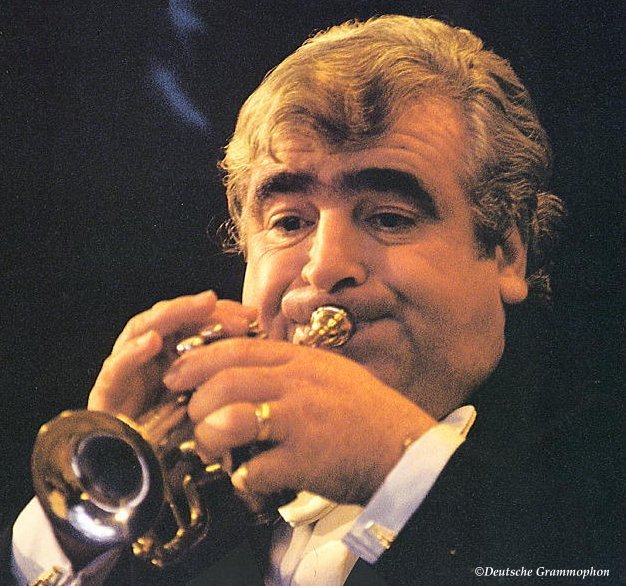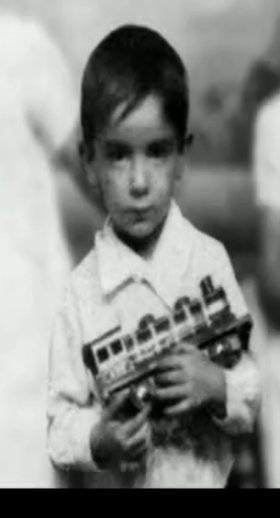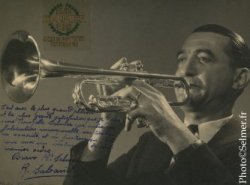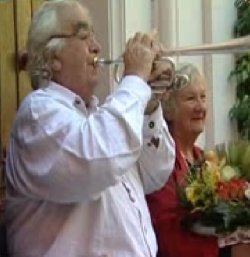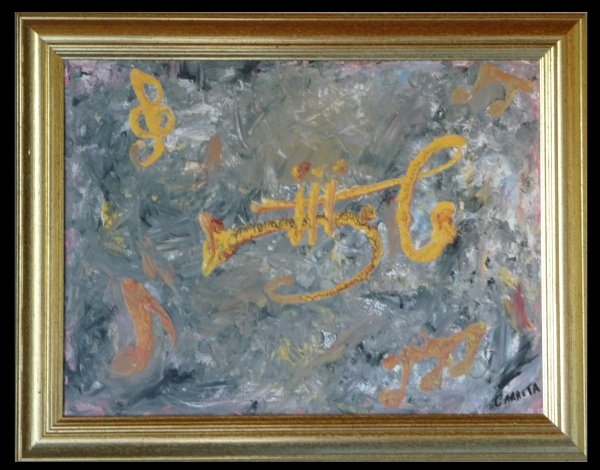Maurice Andre playing his piccolo trumpet: 'In our profession, we must always have this fighting spirit.'Remembering The Greatest
Maurice André a la trompette; La trompette est Maurice André
'He's Not From Our World'
May 21, 1933-February 25, 2012
There are lives and there are destinies. Maurice André’s career belongs to the second category. God put an amazing musical gift in his hands, his father gave him the trumpet, the mine gave him the force and the moral values, Léon Barthélémy saw in this adolescent a prodigy, Raymond Sabarich taught him, and his wife Liliane has followed him and supported him all along his career. This is what I call Destiny, a destiny of light. Without destiny there cannot be any genius. Work is not enough for men, God has to mix in. --Jan Leontsky (from Maurice André’s website)
Maurice André, a coal miner’s son who became a virtuoso credited with having transformed the trumpet from a workaday cog in the back of the orchestra into a seductive solo instrument in front, died on Feb. 25 in Bayonne, in southwest France. He was 78. His family confirmed the death to the news agency Agence France-Presse, declining to specify the cause.
André was to the trumpet what Jean-Pierre Rampal was to the flute or Pablo Casals to the cello: a player whose instrument, long considered a mainstay of the orchestral ark, became, in his hands, the fleet, dazzling tool of a concerto soloist.
From his lips to God’s ears: the astonishing delicacy of André’s touch on ‘Ave Maria,’ first Schubert’s, then Gounod’s."Trumpet players play in orchestras; that's what we do," the conductor Gerard Schwarz, who is a former co-principal trumpeter of the New York Philharmonic, told the New York Times. "Maurice was the only one to actually have a real major career as a soloist and have a real following from audiences all over the world."
At the height of his career, the name of Maurice André was synonymous with the trumpet. Not only was he largely responsible for establishing the trumpet as a popular solo instrument, but he also dominated the scene in the 1960s and 1970s with a punishing schedule of concerts (an average of 180 a year) and more than 300 recordings, many made on his trademark piccolo trumpet.
As the winner of a prestigious international competition in Munich in 1963, he was sought out by the conductor Karl Richter, who needed a player with star quality for the taxing trumpet parts of such works as Bach's B Minor Mass. Other notable conductors with whom André worked at this time included Karl Böhm, Karl Münchinger and Herbert von Karajan. He made an immensely successful recording with Karajan of a transcribed concerto by Vivaldi.
It was the lack of repertoire for the trumpet that persuaded André to make arrangements of works for violin, oboe and other instruments. He played them on the piccolo trumpet, an instrument designed to deliver the higher range with facility, and proceeded to stun audiences with a winning combination of technical brilliance and sweetness of tone.
André was a big man, with bushy eyebrows and fleshy fingers. Often the tiny instrument seemed to disappear from view beneath his hands. But he was a huge inspiration to generations of trumpeters, not least his pupils at the Paris Conservatoire, where he taught as a professor of trumpet from 1967 to 1978, after succeeding his own teacher, Raymond Sabarich, who died in 1966. The teaching tradition at the Conservatoire, embraced and perpetuated by André, inculcated a competitive spirit the trumpeter felt was invaluable to sustaining a professional career. In a 1976 interview in TG Journal ("Opinions of Contemporary European Trumpet Players"), André told Norman E. Smith: "I hear the students individually, in turn, but all the others are listening. It is a very good thing in every regard, for emulation and competition. When I myself was a student at the conservatory, there were great trumpet players such as Marcel Lagorce, who is with the Paris Orchestra; Mr. Ianotot, who is a soloist for the French Broadcasting System; Mr. Pierau, who is also a soloist over the radio; and Mr. Roussel and Mr. Calveras, who are presently soloists in France. There was such a terrible competition in the class among the students. We were all good friends, but on going to the music stand, there was war. We were vying with one another to give the best performance and I think this is necessary in our profession. For in our profession, we must always have this fighting spirit."
Maurice André and Marie Claire Alain play Jean Baptiste Loeillet's ‘Sonata in C for Trumpet and Organ’ at St. Bavo Church, Haarlem, Holland, 1970.
Part 2: Maurice André and Marie Claire Alain play Jean Baptiste Loeillet's ‘Sonata in C for Trumpet and Organ’ at St. Bavo Church, Haarlem, Holland, 1970.He continued to tour after leaving academia, first with his brother Raymond, also a trumpeter, and later with his children Nicolas and Béatrice (trumpeter and oboist respectively).
His farewell concert took place in 2008 in St. Nazaire Cathedral, Béziers, in southern France, by which time André was officially in retirement. He had moved to a hilltop villa in the Basque country, where he developed his talents as a woodcarver and painter, but continued to practice the trumpet for four or five hours a day.
Born in Alès, France, at the foot of the Cévennes mountains, André was the son of a coalminer who was also an amateur trumpet player. His father presented the 12-year-old André with a cornet and was so impressed by the boy's potential that he sent him to study with a friend of his, Léon Barthélémy, a former student at the Paris Conservatoire.
"Dad gave me ‘Lily Lily Bye Bye’ and other little love songs to play...after five days I could play these melodies (they were quarter notes followed by half notes). He got me hooked onto this, then he taught me popular songs. The great method which I practiced with M. Barthélémy, that of Merri Franquin. Yes, the method--the question of soft and loud attacks, all kinds of tonguing. He stuffed me full of these tonguing exercises, pianissimo without forcing the high register or the low. You know, looking back I look on Franquin's method as one of the best."
Raymond Sabarich ((c)Archives Selmer)Having taught André for four years, Barthélémy urged his father to send the boy, who had in the meantime followed his father down the mine, to study at the Paris Conservatoire. Since the family could not afford the fees, André joined a military band, enabling him to secure a free place there. He studied with Raymond Sabarich, receiving first prize for both cornet and trumpet after his first and second years of study.
"Three months after my arrival in Paris, a good lad from the south and all that, Sabarich gave me a real piece of his mind. He had felt straight away that I was gifted, as is said, and so he loaded me with work... and I didn't deliver the goods as he wished. After three months he threw abuse at me and chucked me out of the class. Before his death--poor man--Sabarich always said: ‘lt's when Maurice André woke up.'’ How a good scolding does one good occasionally!"
His early orchestral posts were with the Lamoureux Orchestra (1953-60), the Radio France Philharmonic Orchestra (1953-62) and the Opéra-Comique (1962-67), but his success in the Munich competition effectively launched his career as a soloist. He had in fact been invited to sit on the jury of the competition, but decided to participate himself. It was at this time that he met and married his wife, Liliane, who supported him loyally as manager and companion on his tours, not least in the early years when his career was slow to take off.
A true summit meeting: Maurice André and Dizzy Gillespie meet up for a soulful duet on Luiz Bonfa’s ‘Manha de Carnaval,’ the theme from the movie Black Orpheus.André's eventual success was founded on a solid technique, superb breath control and seemingly inexhaustible stamina, attributed by him to his years in the coal mines: "I built myself up when working in the mine at 14 years old, when I was moving 17 tons of coal a day," he once said.
His technique was formidable. Playing a three-valve Selmer instrument (a fourth valve was added by the manufacturer in 1967 in collaboration with André to extend the register downwards), he effortlessly negotiated the stratospheric pitch range for which the Baroque repertoire was notorious. In the virtuoso faster movements, his tone sparkled brilliantly; in the slow movements it was creamy and seductive. As Karajan once opined: "He's undoubtedly the best trumpet player, but he's not from our world."
Maurice André with his wife Liliane celebrating their 50th wedding anniversary in June 2006. Liliane was Maurice’s manager and the young trumpeter’s most ardent supporter in his early years. The André website describes Liliane as ‘a discreet woman with high human qualities, who greatly contributed to the career of the Master.’Since the 1970s, Baroque performance practice has developed considerably, with more variety of phrasing and articulation. Both soloist and orchestral accompaniments on many of André's recordings now sound inflexible, with dirge-like tempi for slow movements. But at the time, this style of playing was thrillingly new and original. It was his lesser-known predecessor Adolf Scherbaum who introduced the piccolo trumpet and its repertoire, but André who brought it global popularity.
Maurice André performs a duet with his son NicolasThough André was far from a devotee of contemporary music, the sound of which, he said, reminded him of the coal mine, he did have music written for him by several composers including André Jolivet, Henri Tomasi, Boris Blacher, Antoine Tisné and Jean Langlais. A biography, Maurice André: Une Trompette pour la Renommée (A Trumpet for Fame, 2003), was written by his student Guy Touvron, and his memoirs were published under the title Le Soleil Doit Pouvoir Briller pour Tout le Monde (The Sun Has to Shine for Everybody, 2007).
Survivors include his wife, Liliane; a son, Nicolas, a trumpeter; and a daughter Béatrice, an oboist.
Hommage a Maurice André by James Carreta
***
Selected Discography
MAURICE ANDRE EDITION: SUITES, DANCES AND ARRANGEMENTS
Erato
Available at www.amazon.comThe Erato Maurice André Edition of 2011 pulls together the label's recordings of one of the premier classical trumpeters of the 20th century. This volume of six discs contains all the music André recorded between the 1960s and 1980s that was not concertos (which are contained in three other six-disc sets in the Edition). There are some concerto movements here, from concertos for other instruments. André made or had others make (and publish) transcriptions to expand the repertoire available for his instrument and to display a more virtuosic side of it than had been heard before. These movements, and arrangements of opera melodies and more, are found on Discs 2 and 3, where André's talent is allowed to shine, as it does in the Carnival of Venice variations. The first disc is arrangements of famous Bach melodies and other pieces for trumpet and organ, with a double bass and drums giving the music a definite jazzy flavor, a popular trend of the early 1970s. The final discs contain music of the Renaissance and Baroque that feature the trumpet, including Handel's Water Music Suite No. 2 and Clark's Prince of Denmark's March. The complete set is not only a tribute to André, but to his instrument as well. --Patsy Morita, AllMusic.com
TRUMPET CONCERTOS: HANDEL, HAYDN, HUMMEL, HERTEL, ALBINONI, TELEMANN
Maurice André
EMI Classics
Available at Arkiv Music
TOOT SUITE FOR TRUMPET & JAZZ PIANO
Maurice André and Claude Bolling
Sony
Available at www.amazon.comClassical trumpeter Maurice André tries his hand at a Claude Bolling classical/jazz suite, whose titles are getting more precious with each new work. Indeed, parts of Toot Suite are overrun with a terminal case of the ‘cutes’--the hybrid ‘Rag-Polka’ especially--as Bolling's writing perhaps is pandering a bit toward the element in his mass audience that likes entertaining, featherweight novelties. But despite some evidence of wear, Bolling remains capable of turning out appealing tunes like the jazz waltz ‘Allegro’ and the Parisian boulevard-flavored ‘Spirituelle.’ André is an impeccable trumpeter, clean, sweet-toned and articulate to a fault; to accomodate his talents and his instrument collection, Bolling spreads the six movements among five different horns (C and E-flat trumpets, B-flat piccolo trumpet, cornet and flugelhorn). Guy Pedersen (bass) and Daniel Humair (drums) round out the team. (by Richard S. Ginell)
Bolling, while being a beast on jazz piano, is best know for his compositional skills. Listen to this album and you'll know why. Each piece has it's own distinct style, but all have that amazing jazz groove without being pure jazz. In addition, Maurice Andre is considered to be the greatest classical trumpeter of all time, and this album shows off his many skills, from the mellow flugelhorn to his brilliant pic trumpet work, he is a master of all styles. Jazz fans, pianists and trumpeters will love this album, as well as classical buffs looking for something different. Truly great stuff here. (by Yahn Van de Walle, posted at Many Fantastic Colors)
Founder/Publisher/Editor: David McGee
Contributing Editors: Billy Altman, Laura Fissinger, Christopher Hill, Derk Richardson
Logo Design: John Mendelsohn (www.johnmendelsohn.com)
Website Design: Kieran McGee (www.kieranmcgee.com)
Staff Photographers: Audrey Harrod (Louisville, KY; www.flickr.com/audreyharrod), Alicia Zappier (New York)
E-mail: thebluegrassspecial@gmail.com
Mailing Address: David McGee, 201 W. 85 St.—5B, New York, NY 10024


